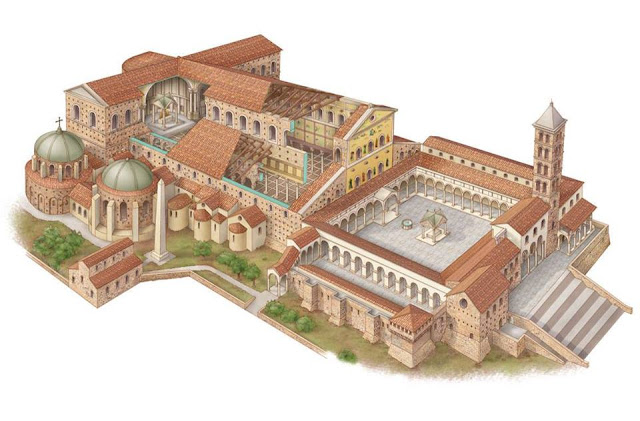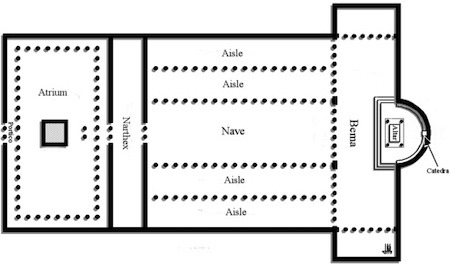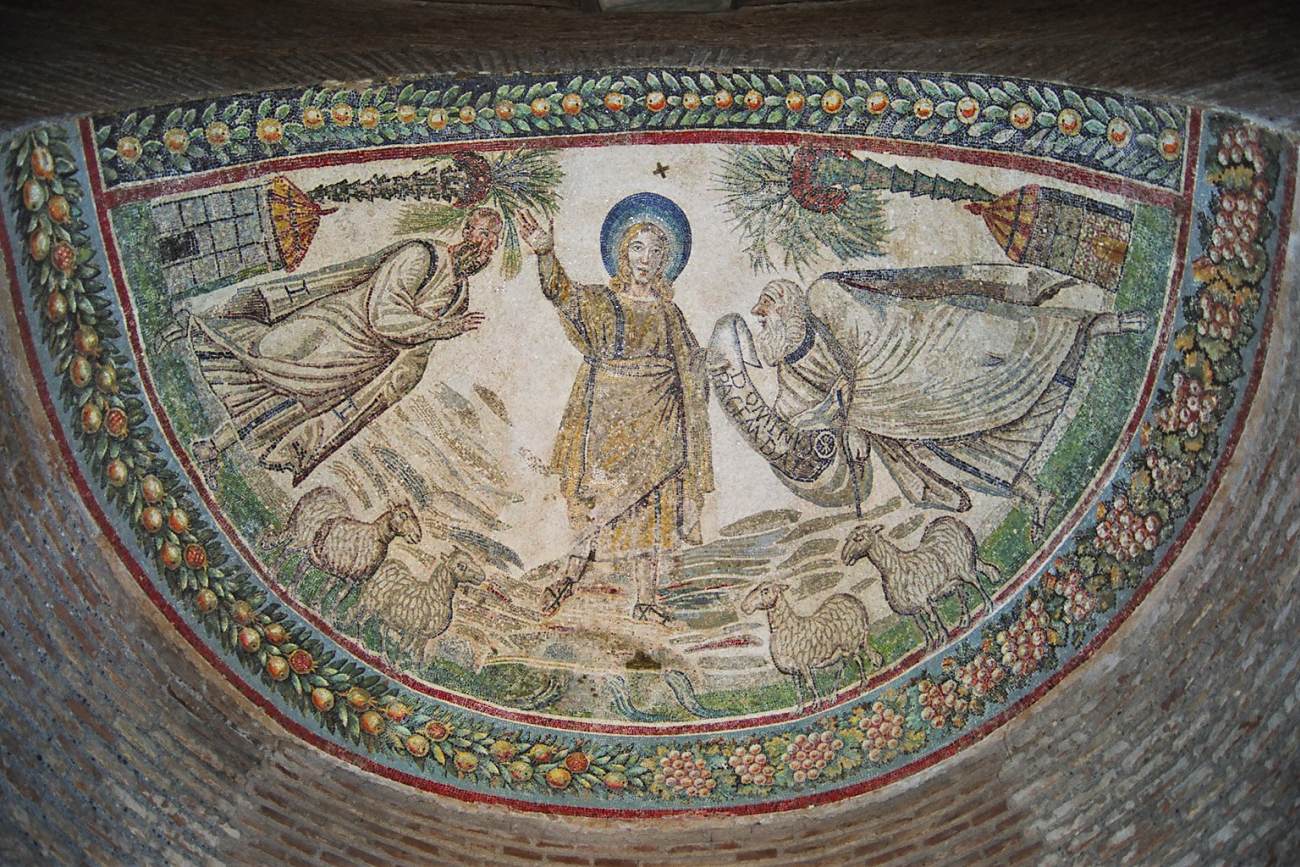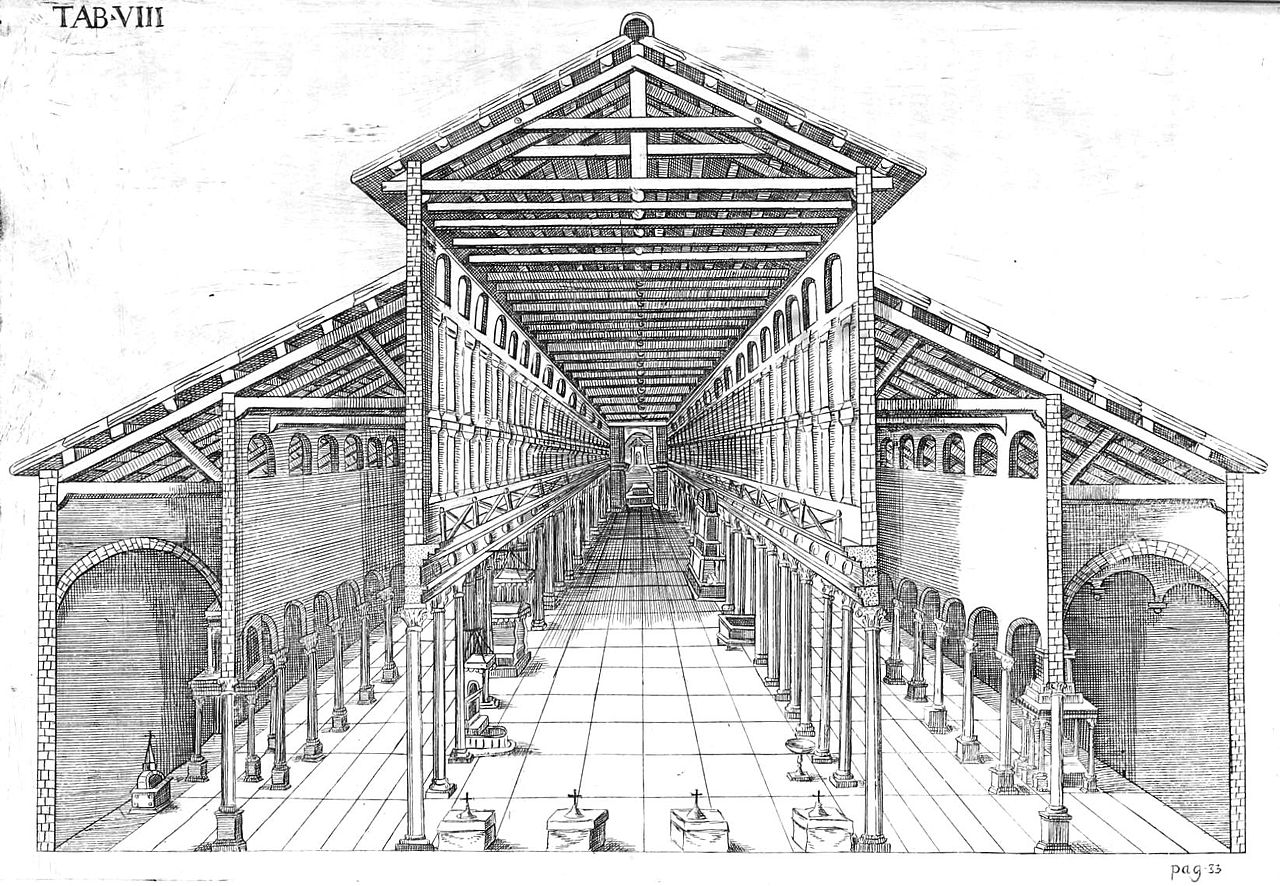Basilicas
Old St Peter's Basilica was the most significant basilica built at the time and contained the remnants of St. Peter.

The Context
Because of religious persecution, Early Christians were not able to establish official public places of worship until after the year 300. In 312 Emperor Constantine issued the Edict of Milan which put an end to Christian persecution in Rome and legalized the faith. With this legalization of Christianity, the growing Early Christian population was in need of official places of worship. To aid the faith, Constantine constructed these necessary places of worship in the form of basilicas across his empire.
This diagram depicts the general layout of the Early Christian Basilica.

The Structure
The Christian basilica consisted of a rectangular space divided into a central hall (later called the nave), with side aisles separated by a colonnade. At the eastern end of the nave was the raised platform of the sanctuary with a canopied alta. Behind the altar was a bishop's chair (cathedra), with seats for the priests and deacons on either side. The sanctuary was separated from the nave by a triumphal arch. Because the sanctuary with altar and cathedra were piritually most important in the hierarchy of the Christian basilica, the apse and the triumphal arch were typically decorated with paintings or mosaics depicting bible stories and church teaching. These buildings also often had an atrium either off to the side or in front of the structure.
The altar was made up of stone and placed upon a raised platform with stairs. Within or below the altar were placed the remains of a saint if the basilica wasn’t already built upon a saint’s tomb. The entire design of the basilica looked to emphasize the importance of the altar as the central place of the Mass. The art and architecture worked together to lead the eye down the central aisle of the nave toward the altar at the center of the sanctuary. These basilicas are also early examples of when Chrisitan architecture started taking the shape of crosses when viewing them from the top down.
Mosaics often adorned the walls and ceiling of Early Christian Basilicas.

Relation to the Church
These new basilicas gave a growing Christian community places to worship in the Roman Empire. These basilicas suited the Christians’ needs and allowed a place for the faithful to worship away from the unfaithful.
The architectural contrast of a pagan temple to a christian basilica is symbolic of the christian faith in general. Typically temples were designed to be outwardly appealing while Christian basilicas were designed to be appealing within just as Christianity focuses on the inner value of a human being as a child of God. The mosaics within the basilicas helped the church community to understand church teachings through their depiction of those teachings along with biblical stories and figures.
The most significant basilica built was Old St. Peter’s Basilica. Some of the other significant Roman basilicas of the early Church were St. John Lateran (324), St. Paul Outside-the-Walls (386), and St. Mary Major (432). Along with St. Peter's, these churches became known as the "patriarchal basilicas of Rome." The two most unaltered basilicas from the Early Christian era, however, are Santa Sabina (422) in Rome and Sant'Apollinare (520) in Ravenna.
The inner architecture of Early Chrisitan Basilicas sought to direct attention towards the altar as the centeral place of sacrifice.

Modern Application
One major concept that we can take away from the introduction of basilicas into the world is the symbolism of the focus on inner beauty as opposed to outer beauty. As Catholics, our faith focuses on the concept of inner spirituality just as Early Christians did back then. However, sometimes as people of faith we can focus too much on pointing fingers at others who we think are acting in unholy or undignified ways. Even if we think that we are correct in some way, it is important that as people of faith that we examine ourselves in order to make sure that we are not hypocritical and to make sure that we are acting as examples of Christ ourselves. We can put more of our focus on looking inward and seek to make ourselves better examples of Catholics.
Another element of the basilicas that we can take into our modern world is the use of biblical stories to convey church teaching. In basilicas this was done in mosaic form, but today we can use other forms of communication to spread the word of God. Our modern world gives us many forms of communication like social media or text messages. Whether we choose to use these forms of communication or not, we can always look to draw examples, either from the bible or real life, to exemplify church teaching and continue the mission that God gave us to evangelize the world.